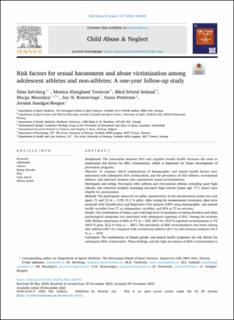Risk factors for sexual harassment and abuse victimization among adolescent athletes and non-athletes: A one-year follow-up study
Sølvberg, Nina; Torstveit, Monica Klungland; Solstad, Bård Erlend; Mountjoy, Margo; Rosenvinge, Jan Harald; Pettersen, Gunn; Sundgot-Borgen, Jorunn
Peer reviewed, Journal article
Published version

View/
Date
2023Metadata
Show full item recordCollections
Original version
Sølvberg, N., Torstveit, M. K., Solstad, B. E., Mountjoy, M., Rosenvinge, J. H., Pettersen, G. & Sundgot-Borgen, J. (2023). Risk factors for sexual harassment and abuse victimization among adolescent athletes and non-athletes: A one-year follow-up study. International Journal of Child Abuse & Neglect, 147, 1-11. https://doi.org/10.1016/j.chiabu.2023.106592Abstract
Background The association between SHA and negative mental health increases the need to understand risk factors for SHA victimization, which is important for future development of prevention programs. Objective
To examine which combinations of demographic- and mental health factors were associated with subsequent SHA victimization, and the prevalence of elite athletes, recreational athletes, and reference students who experienced sexual revictimization. Participants and setting Norwegian elite athletes and recreational athletes attending sport high schools, and reference students attending non-sport high schools (mean age: 17.1 years) were eligible for participation. Methods The participants answered an online questionnaire at two measurement points one year apart, T1 and T2 (n = 1139, 51.1 % girls). After testing for measurement invariance, data were analyzed with Classification and Regression Tree analysis (CRT) using demographic- and mental health variables from T1 as independent variables, and SHA at T2 as outcome. Results The combination of being a girl with high level of symptoms of eating disorders and other psychological symptoms was associated with subsequent reporting of SHA. Among the students with lifetime experience of SHA at T1 (n = 533, 58.3 %), 49.5 % reported revictimization at T2 (60.9 % girls, 32.2 % boys, p ≤ .001). The prevalence of SHA revictimization was lower among elite athletes (44.3 %) compared with recreational athletes (49.1 %) and reference students (59.4 %, p = .019). Conclusion The combination of female gender and mental health symptoms are risk factors for subsequent SHA victimization. These findings, and the high prevalence of SHA revictimization is important knowledge for developing preventive programs targeting elite athletes, recreational athletes, and reference students.
